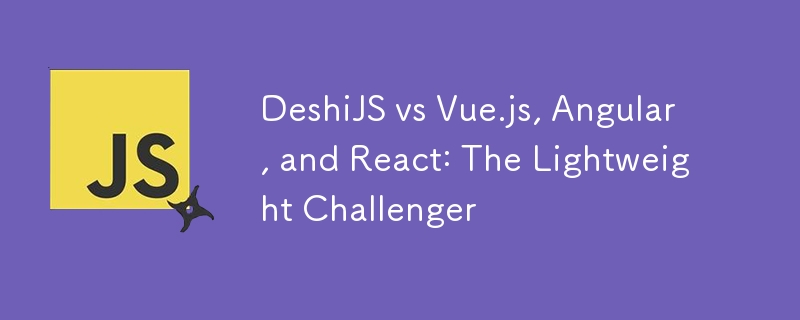

DeshiJS is a new, lightweight JavaScript framework that is designed to be fast, intuitive, and scalable. At just 10KB, **DeshiJS **focuses on providing developers with a minimal, reactive core, making it ideal for small to medium-sized projects where performance and simplicity are key. Let's take a look at how it compares to the heavyweights: Vue.js, Angular, and React.
DeshiJS
Here's the updated blog post with a mention of DeshiJS’s support for a reusable component system:
DeshiJS vs Vue.js, Angular, and React: The Lightweight Challenger
DeshiJS is a new, lightweight JavaScript framework that is designed to be fast, intuitive, and scalable. At just 10KB, DeshiJS focuses on providing developers with a minimal, reactive core, making it ideal for small to medium-sized projects where performance and simplicity are key. In addition, DeshiJS supports a reusable component system, making it easier to build modular and maintainable applications. Let's take a look at how it compares to the heavyweights: Vue.js, Angular, and React.
Vue.js is widely known for its progressive nature, allowing you to adopt it incrementally. Vue is great for component-based development and has an easy learning curve, similar to DeshiJS. However, Vue’s bundle size can range from 30KB to 100KB, depending on the setup.
Size: DeshiJS is 10KB, while Vue is more heavyweight with a larger ecosystem.
Learning Curve: Both have a relatively easy learning curve, but **DeshiJS **is simpler due to its minimal API.
Reusable Components: Both Vue and **DeshiJS **support reusable components, but **DeshiJS **focuses on a simpler and lighter system.
Flexibility: Vue offers more flexibility and tools for larger projects, whereas **DeshiJS **focuses on being lightweight and fast for smaller projects.
Angular is a complete framework for building enterprise-level applications. It offers a robust structure, which includes features like dependency injection, two-way data binding, and RxJS for reactive programming. However, this comes with a much larger bundle size, typically exceeding 500KB after tree shaking.
Size: DeshiJS is significantly smaller at 10KB, while Angular is bulky, making it more suitable for large-scale applications.
Use Case: Angular is ideal for large, enterprise-level applications with complex requirements, while DeshiJS is more suitable for simple, reactive apps.
Reusable Components: Angular's component system is powerful but complex. DeshiJS, on the other hand, offers a simpler reusable component system that is easier to implement and use.
Complexity: Angular has a steep learning curve due to its comprehensive feature set, while DeshiJS is easier for developers who prefer a simpler framework.
React is widely popular for its component-based architecture and virtual DOM implementation. It's known for building highly dynamic UIs. React's core bundle size is about 30KB, but when paired with libraries like React-Router and Redux, the overall size increases.
Size: DeshiJS is much smaller, weighing in at 10KB, compared to React’s base 30KB+.
Simplicity: React introduces JSX and requires additional libraries for routing and state management, while DeshiJS provides simplicity and doesn’t require extra tooling.
Reusable Components: Both DeshiJS and React offer support for reusable components. DeshiJS’s system is lightweight and intuitive, while React’s system is more extensive but requires more setup.
Reactiveness: Both frameworks are reactive, but DeshiJS focuses on delivering this in the lightest form possible, ideal for developers who want the core essentials.
**DeshiJS **is built for developers looking for a minimal framework that doesn’t compromise on speed, reactivity, and component modularity. It’s perfect for smaller projects, personal websites, or apps where performance and bundle size are critical.
Ultra-lightweight: At just 10KB, it's faster to load and doesn’t bloat your app.
Simplicity: Its small API surface makes it easy to learn and start using right away.
Reusable Components: DeshiJS offers a simple and effective reusable component system for building modular UIs.
Scalability: While minimal, it’s scalable enough to handle modern reactive features.
For small to medium-sized projects: Where performance and size matter more than extensive features.
For rapid prototyping: When you need to quickly put together an app without a steep learning curve.
For those seeking simplicity: If you find Vue, Angular, or React too heavy or complex for your needs.
For reusable components: **DeshiJS **offers a lightweight solution for building reusable, modular components without the overhead of larger frameworks.
The above is the detailed content of DeshiJS vs Vue.js, Angular, and React: The Lightweight Challenger. For more information, please follow other related articles on the PHP Chinese website!




